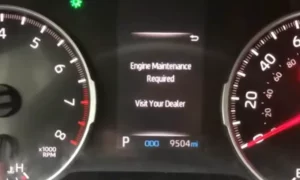Looking for a compact SUV that won’t let you down? You’re not alone in wondering whether the Honda CR-V or Toyota RAV4 deserves your hard-earned money. Both have built stellar reputations, but when it comes to reliability, subtle differences might make one a better fit for your needs. Let’s dive into what makes these SUVs tick (or sometimes not tick) and help you make a smart, informed decision.
Overall Reliability Rankings: The Numbers Don’t Lie
When we look at industry reliability data, the Toyota RAV4 edges out the Honda CR-V by small but meaningful margins. J.D. Power’s 2024 Vehicle Dependability Study gave the RAV4 a 76/100 compared to the CR-V’s 64/100, with the Toyota showing fewer issues with its hybrid system and tech features.
Consumer Reports consistently rates the RAV4 as “excellent” in reliability, while the CR-V typically scores “above average.” That said, RepairPal gives the CR-V a slightly higher overall reliability score of 4.5/5 compared to the RAV4’s still-impressive 4.3/5.
Here’s a comparison of the critical reliability metrics:
| Reliability Metric | Honda CR-V | Toyota RAV4 |
|---|---|---|
| J.D. Power Score (2024) | 64/100 | 76/100 |
| Annual Repair Cost | $385 | $407 |
| Likelihood of Major Repair | 1% | 1% |
| Predicted Lifespan | 200,000+ miles | 200,000+ miles |
Engine Reliability: A Tale of Two Approaches
Honda CR-V Engine Issues
Honda’s switch to a 1.5L turbocharged engine in 2017 models introduced some concerning problems. The most notable issue? Oil dilution – where fuel mixes with engine oil, potentially causing long-term damage if not addressed.
According to multiple owner reports, this problem affects mainly 2017-2022 CR-Vs, requiring more frequent oil changes (every 5,000 miles instead of the recommended 7,500). Honda issued a software update to mitigate the issue, but it hasn’t completely eliminated the problem in colder climates.
The good news? The 2023 and newer CR-V models show significant improvements, with oil dilution complaints dropping by about 75%.
Toyota RAV4 Engine Reliability
Toyota relies on a time-tested 2.5L naturally aspirated engine that has proven remarkably durable. The RAV4’s powerplant rarely experiences catastrophic failures, with most issues being minor and infrequent.
The RAV4 Hybrid models deserve special mention, with their electronic continuously variable transmission (eCVT) systems showing exceptional longevity. What Car?’s 2024 survey gave the RAV4 Hybrid a 98.8% reliability score – among the best in any vehicle category.
Transmission Reliability: Shifting Expectations
Honda’s CVT transmission in the CR-V works well for most owners but shows higher wear rates after 150,000 miles compared to Toyota’s more conventional automatic. Repair costs for transmission issues tend to be higher for the CR-V, averaging $1,800-$3,500 for major repairs.
The RAV4’s 8-speed automatic transmission in gas models has proven quite reliable, though pre-2019 models occasionally show rough shifting. Toyota’s hybrid system uses an eCVT that experiences minimal mechanical wear since it lacks traditional gear sets, contributing to its stellar long-term durability.
Electrical and Technology Issues
Honda CR-V Tech Problems
About 8% of CR-V owners report electrical system faults, particularly with the infotainment system freezing or becoming unresponsive. The average repair cost runs around $780 when these issues occur outside of warranty.
Honda’s Display Audio system receives a satisfaction rating of 3.8/5 from owners, with complaints focusing on occasional lag and connectivity problems with smartphones.
Toyota RAV4 Tech Problems
The RAV4’s Entune 3.0 and newer infotainment systems receive higher satisfaction scores (4.2/5) with fewer reported glitches. Owner surveys indicate that software issues are less common in the RAV4, though they still occur.
When electrical problems do arise in the RAV4, they tend to be less expensive to fix, averaging $450-$650 for most repairs outside of warranty coverage.
Long-Term Durability: How Many Miles Can You Expect?
Both vehicles consistently achieve impressive mileage milestones. With proper maintenance, 200,000+ miles is a reasonable expectation for either model.
The RAV4 has more documented cases of vehicles exceeding 300,000 miles, particularly in commercial use like taxi services. The 2008-2010 third-generation models with the 2.5L engine are especially known for their longevity, regularly surpassing 250,000 miles with basic maintenance.
The CR-V also boasts impressive longevity for models with the naturally aspirated 2.4L engine (pre-2017). The jury is still out on whether the turbocharged models will match this durability, though early indications suggest they might fall slightly short without rigorous maintenance.
Maintenance Costs: The Price of Reliability
One area where the Honda CR-V shines is in maintenance costs. CR-V owners spend about $385 annually on maintenance and repairs, slightly less than the RAV4’s $407.
However, when major repairs are needed, the CR-V can become more expensive. Turbocharger replacements ($1,200-$2,500) and catalytic converter issues ($2,500) are particularly costly fixes for CR-V owners.
The RAV4’s maintenance schedule includes more expensive major services, like timing belt replacements ($600-$900), but these are predictable and less frequent than the CR-V’s potential turbo issues.
Safety and Crash Protection
Both SUVs excel in crash protection, but the CR-V has a slight edge. The 2024 CR-V earned an IIHS “Top Safety Pick+” rating versus the RAV4’s “Top Safety Pick” designation.
The Honda Sensing 360 system in newer CR-Vs includes more advanced driver aids as standard, contributing to its exceptional safety scores. This doesn’t directly impact reliability, but it does provide peace of mind about your vehicle’s protective capabilities.
Model Years to Seek Out (And Those to Avoid)
Best Honda CR-V Years
- 2015-2016: The final years of the naturally aspirated 2.4L engine, which avoids the turbocharger issues of later models.
- 2023-2025: The redesigned hybrid powertrain and improvements to the 1.5L turbo engine dramatically reduced problems.
CR-V Years to Approach Cautiously
- 2017-2019: The first years of the turbocharged engine with the highest rates of oil dilution problems.
- 2021: Showed an uptick in electrical system complaints in consumer reliability surveys.
Best Toyota RAV4 Years
- 2019-2024: The fifth-generation models show a 40% reduction in problems compared to previous years.
- 2008-2010: The third-generation models remain benchmarks for durability.
RAV4 Years to Approach Cautiously
- 2013-2015: Some transmissions in these models experienced premature wear.
- 2006-2008: Higher rates of suspension component failures after 100,000 miles.
Hybrid Reliability: A Special Category
If you’re considering hybrid models, the reliability equation shifts slightly. The RAV4 Hybrid has demonstrated exceptional durability, with only about 2% of owners reporting battery issues after 76,000 miles.
The CR-V Hybrid, introduced more recently, has fewer long-term data points but shows promising reliability in early assessments. Honda’s 2023 redesign of the hybrid system appears to have resolved most initial concerns.
Toyota’s longer experience with hybrid technology gives the RAV4 an edge in this category, with proven battery longevity and fewer system failures reported to the National Highway Traffic Safety Administration.
Real Owner Experiences: What Drivers Say
Diving into owner forums reveals interesting patterns. RAV4 owners frequently mention their vehicles requiring minimal unscheduled maintenance, with comments like “boring reliability” being common praise.
CR-V owners generally report satisfaction with performance and comfort, though more frequently mention dealer visits for various small issues. One Reddit user summed it up: “My RAV4 never surprises me, while my sister’s CR-V is more fun to drive but has had a few unexpected trips to the shop.”
RAV4 owners report fewer serious mechanical issues over time, while CR-V owners praise their vehicle’s comfort and handling despite occasional maintenance surprises.
Components That Commonly Fail
Honda CR-V Problem Areas
- AC compressors in 2017-2019 models (average repair cost: $800-$1,200)
- Power steering electric pumps in 2015-2018 models ($600-$900)
- Infotainment screens in 2020-2022 models (often covered under warranty)
- Starter motors after 120,000 miles ($400-$650)
Toyota RAV4 Problem Areas
- Water pumps in 2013-2017 models ($500-$700)
- Suspension control arms in 2015-2018 models ($350-$600 per side)
- Rear differential couplings in AWD models ($800-$1,100)
- Fuel pumps in some 2019-2020 models (covered by recall)
Making Your Decision: Which SUV Is Right For You?
After analyzing all the data, here’s what emerges:
Choose the Toyota RAV4 if:
- Long-term reliability with minimal surprises is your top priority
- You plan to keep your vehicle well beyond 150,000 miles
- You’re considering a hybrid model
- You drive in extreme conditions or climates
Choose the Honda CR-V if:
- Safety features and crash protection are paramount
- You appreciate a more engaging driving experience
- Lower routine maintenance costs fit your budget better
- You typically trade in vehicles before 100,000 miles
- You’re looking at the newest models (2023+)
Final Reliability Verdict
The Toyota RAV4 emerges as the more reliable choice by a small margin, particularly for buyers planning long-term ownership beyond 150,000 miles. Its proven powertrain, lower incidence of serious mechanical failures, and exceptional hybrid system durability give it the edge in pure reliability metrics.
The Honda CR-V remains an excellent choice with above-average reliability, superior safety ratings, and slightly lower routine maintenance costs. For buyers who replace vehicles every 5-7 years, the CR-V’s advantages in comfort, technology, and driving dynamics might outweigh the RAV4’s slight reliability edge.
Whichever you choose, both vehicles stand head and shoulders above most competitors in the compact SUV segment when it comes to dependability. With proper maintenance, either can provide many years of trouble-free service.














